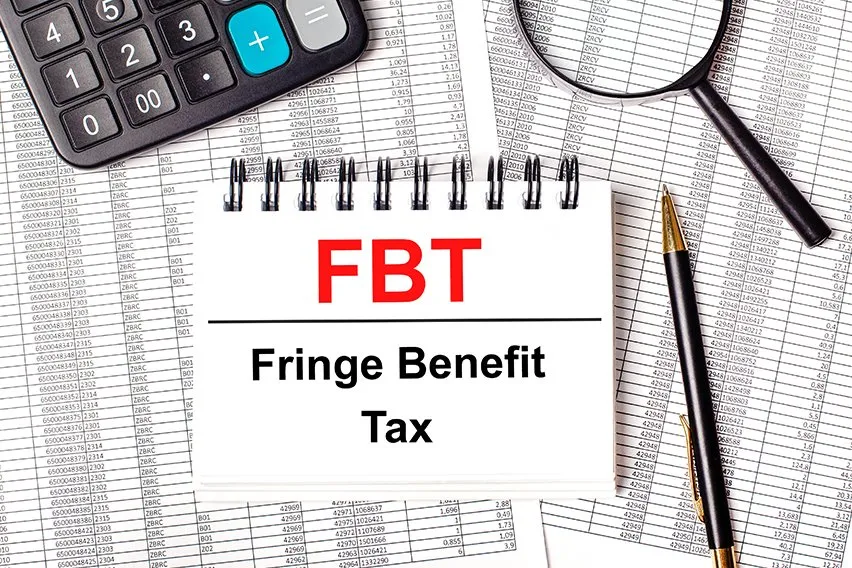A Comprehensive Guide to Fringe Benefits Tax

Fringe benefits are a type of compensation that is not included as part of an employee’s taxable income. Types of fringe benefits can include health insurance and retirement contributions. They can also include reimbursement for education or travel expenses. Employers often offer these types of fringe benefits to help attract the best talent. It is important for employees to understand how they will affect their tax situation before accepting them.
This article is a comprehensive guide about fringe benefits. It will provide information on what fringe tax benefits are, how they affect your taxes, if they are taxable and more. It will also discuss filing taxes related fringe benefits for employers and employees. Read on to learn more about fringe benefits and their tax implications.
Here’s What We’ll Cover:
How Do Fringe Benefits affect Your Taxes?
Tips for Determining Taxable Vs Nontaxable Benefits
Fringe Benefits for Remote Employees
Do Employees Pay for Fringe Benefits?
What Can Employers Do to Help Minimize Taxes?
What is the Effect of Fringe Benefits on Unemployment?
Fringe Benefits and Award Programs
Common Misconceptions about Fringe Benefits
Fringe Benefits and FIling Your Taxes
What Are Fringe Benefits?
Fringe benefits are also known as qualified non-cash fringe benefits (QNBF). They are a type of compensation that is not included as part of an employee’s taxable income. Employers often offer fringe benefits in order to attract the best talent. It is important for employees to understand how they will affect their tax situation before accepting them.
Here is more information about some of the most common types of Fringe Benefits:

Retirement Contributions
One of the most common types of fringe benefits is retirement contributions. Employers may offer matching contributions for an employee’s 401(k) or 403(b) retirement savings plan. This type of fringe benefit can take many forms. These include employer-matching funds, profit sharing or even stock options.
All three are considered qualified fringe benefits. This is because they are non-cash contributions made to an account meant for retirement. They have the added benefit of being tax-deductible for employers. They may be excluded from employees’ taxable income as well.
Health Insurance
A common type of fringe benefit is health insurance. Employers may offer employees group health insurance plans as a fringe benefit. These types of benefits may also be referred to as qualified nonelective contributions. They can also be known as qualified matching contributions.
Health insurance is reported on W-2 forms for individual taxpayers. It does count toward taxable income. There are several types of fringe benefits that do not qualify as taxable income. These include reimbursements for health care expenses, premiums for long-term care insurance, and fixed indemnity policies.
Education Expenses
Employers may offer an education reimbursement plan. These will pay for any education expenses incurred by employees related to their job. An employer may pay for courses, books or equipment related to the business.
Employers are not required to offer this type of fringe benefit. Many do in order to attract the best prospects. There are specific guidelines that must be followed when offering an education reimbursement plan. The most important being that employees cannot have their educational expenses paid by employers in the year before they were hired.
Child Care Assistance
A common type of fringe benefit offered by employers is child care assistance. This can be in the form of an onsite childcare facility or subsidized daycare.
This particular type of fringe benefit may be one of the most beneficial to employees. It is also one that is often overlooked. Child Care assistance is a way for working parents to save money. Employees may be able to deduct childcare expenses. This includes costs such as daycare and after-school care.
Transit Benefits
A common type of fringe benefit is transit benefits. Employers may offer employees the option to have a monthly amount withheld from their paychecks for public transportation or mass transit.
This reduces the cost of commuting for employees. It also helps employers with decreasing their carbon footprint by offering alternative means of transportation. Commuting costs are tax deductible for employees.
Employee Stock Purchase Plans
Another common type of fringe benefit is an employee stock purchase plan (ESPP). This allows employees to buy company stock at a discounted rate. It is paid for by either the employer or employees themselves.
This type of fringe benefit can be beneficial to both parties. It allows employees to have a stake in the company. This can be good for morale and company loyalty. The discount from an ESPP is not considered taxable income for employees.
How Do Fringe Benefits affect Your Taxes?
Fringe benefits affect the taxes of the employee and employer differently. Employees will usually receive a W-2 form that specifies the amount of income earned through fringe benefits.
Employers can take a deduction on their taxes if they pay for fringe benefits with pre-tax dollars. They are also provided the opportunity to offer tax-free benefits to employees under certain guidelines. For example, employers cannot offer tax-free childcare assistance if that is available through another program.
How Do You Claim Fringe Benefits?
In order to claim a fringe benefit as an employee, you will need to file the necessary tax forms. In many cases, this may require filing a 1099-MISC form or W-2 form with your income tax return. This depends on how much was withheld from your paycheck for the benefit.
When filing income taxes, you will need to include any fringe benefits received in your taxable income. You can claim expenses for things like commuting and daycare, but not amenities like gym memberships or transit passes.
What are Some Other Examples of Fringe Benefits?
Some examples of fringe benefits are employee discounts, stock options, educational assistance, child care assistance and more.
There are many different types of fringe benefits that employers may offer. These include things like free or discounted merchandise or services for employees. Employers can also provide transportation to and from work for employees in the form of mass transit passes or reimbursements. Other benefits employers may offer include education assistance, child care assistance and babysitting services.
Tips for Determining Taxable Vs Nontaxable Benefits
There are several guidelines to follow in order to determine if a fringe benefit is taxable or nontaxable.
For example, any benefits that are not included on the W-2 form should be considered nontaxable. These would include things like gym memberships, transit passes and other amenities offered by employers for employees’ personal use. According to the IRS, these must be reported on Form 1040, but are not taxable.
Other types of fringe benefits that are nontaxable per the IRS guidelines include most meals and lodging provided for the employer’s convenience. However, this does not include any meals you purchase while travelling away from home.
If you are unsure, always consult with your personal accountant for proper guidance. Sometimes it can be difficult to determine what fringe benefits are taxable or nontaxable in your specific situation. Remember to always claim any fringe benefits on your income taxes so you aren’t paying incorrect amounts.
Fringe Benefits for Remote Employees
Fringe benefits for remote employees may require special consideration. If you are a telecommuter, your employer may be able to provide additional fringe benefits. These would be in place of traditional work benefits like health insurance, life insurance and retirement plans.
Some employers will allow telecommuters to enroll in flexible spending accounts (FSA). This allows an employee to use pre-tax dollars to pay for your daycare and commuting expenses.
Commuting expenses may also be reimbursed by employers who provide their employees with company vehicles, fuel cards or parking passes. Their business owners can claim these as a tax-deductible expense on their income taxes.
In some cases, employers can offer their employees a contribution to an FSA or HSA for medical expenses. This is generally only allowed if an employee maintains a tax home and workspace separate from the family home.
Employers who provide these types of fringe benefits may still be required to file 1099-MISC forms with the IRS.
Do Employees Pay for Fringe Benefits?
Fringe benefits can potentially be paid for by both employers and employees. For example, an employer may pay for an employee’s transportation to and from work. The employee may then choose to reimburse the employer for this benefit in order to keep their own commuting costs down.
What Can Employers Do to Help Minimize Taxes?
Employers can reduce their tax liability by offering employees income-based fringe benefits. They can also help employees reduce their income taxes by offering them benefits on a pre-tax basis. For example, many employers offer dependents’ dental and vision care on a pre-tax basis. This helps employees save money while paying for their medical expenses.
In order to qualify for these tax breaks, an employer must meet certain criteria under the IRS guidelines. According to the IRS, an employer must offer more than de minimis (a minor or trivial benefit) and provide these benefits on a nondiscriminatory basis.
What Is De Minimis?
According to the Internal Revenue Code, “de minimis” means of such small significance or trifling import as not to merit attention or consideration. This basically means that fringe benefits do not need to be substantial and can be in the form of amenities like gym memberships, transit passes and parking.
What is the Effect of Fringe Benefits on Unemployment?
Fringe benefits that an employer provides as a reward for employment are taxable as income under the Federal Insurance Contributions Act (FICA). That means both employers and employees have to pay taxes on these benefits up front. This can be a costly benefit to employers. Fringe benefits can cause unemployment rates to increase because they make it difficult for employers to hire new employees.
Fringe Benefits and Award Programs
When employers offer fringe benefits as a reward for employment, they may also offer them as part of an award program. These awards are typically noncash prizes for long-term employment with the company. They can include things like vacations, household items and even vehicles.
Awards that are given to employees must be taxable unless other conditions are met. Employers and employees must both pay tax on these benefits under the Federal Insurance Contributions Act (FICA).
Employers must also meet certain criteria in order to qualify for exemption from FICA taxation. According to Internal Revenue Code, employers can offer awards as nontaxable benefits if they are offered on a de minimis basis and if the awards are given in recognition of employment.
It is important that employers comply with all current Federal, state and local tax laws to avoid any penalty fees. According to the Internal Revenue Code, if an employer fails to meet all of these requirements, they may be liable for tax penalties and fines.
Common Misconceptions about Fringe Benefits
There are many misconceptions surrounding fringe benefits. One of the main misconceptions is that they are always nontaxable. While this may be the case for some types of employer-provided fringe benefits, there are exceptions. Fringe benefits can include health care plans, life insurance coverage and gym memberships.
Here are some other common misconception:
- Fringe benefits provided to the employee are always tax free.
- The company providing the fringe benefit is always responsible for filing taxes on that benefit.
- An employer cannot pay an employee’s personal expenses as a fringe benefit without running into tax consequences.

Fringe Benefits and FIling Your Taxes
If you are using a professional tax software, it will automatically determine if any of your fringe benefits are taxable. It should also calculate how much money you can take off of your taxes. All you will need to do is enter the amount and type of benefit that you received. The software should provide an estimation of your tax liability.
Here is some of the top tax filing software to help you file your taxes properly.
-
TurboTax
TurboTax is a popular online tax preparation software that makes filing your taxes easy. It provides you with up-to-date rates, deductions and credits. You can even do state taxes from your home computer. It also includes the W2 section for employers. iIt will automatically detect any taxable benefits that you may have received. This will save you time and money.
TurboTax also has a free edition and a deluxe edition. The free version includes free federal and state filing. It can be used by almost anyone, not just those with simple tax returns. The deluxe edition adds features like priority customer support, one-on-one audit support, discounts on investments and more.
You will link your actual W2 from your employer to this software and it will detect the benefits and estimate your tax liability. It will make filing your taxes as easy as possible and can be done at home.
TurboTax is trusted by millions of people throughout North America. It provides excellent customer support and an easy-to-use interface for all customers. You even get free tech support from tax experts when you purchase TurboTax.
-
TaxAct
TaxAct is an online tax preparation software that makes filing your taxes easier than ever. They also have access to millions of free, printable forms and schedules. This will help speed up the filing process and make things more accurate on your end as well. This software provides W2 information along with your other tax documents.
TaxAct also provides audit support and advice from real CPAs and EAs. You can even connect with a CPA or EA for free via phone, chat or screen sharing. This is perfect for new businesses and beginners.
TaxAct offers three different packages for you to choose from. All have the same capabilities. Some are more feature-rich as you purchase higher tiers. The free version offers unlimited support via phone, chat and screen sharing, along with free W2 forms.
The Basic version adds things like audit assistance and preparation guidance for 1040EZ or 1040A returns. The Plus version adds additional guidance for self-employed individuals, rental property owners and homeowners.
The Premium version includes everything from the previous editions plus much more. It includes priority access to customer support representatives and a year’s worth of full product updates.
-
H&R Block
H&R Block is one of the oldest and most trusted providers of tax preparation software. They have been helping people file their taxes for decades. The same familiar faces are still there to help you. They now offer more than just simple returns.
H&R Block provides everything you need for filing your taxes including free W2 forms. You can even get your taxes done with a quick interview, which will make the process much faster.
H&R Block also provides tax advice directly from CPAs and Pros. They have hundreds of locations throughout North America to meet with you face-to-face. They can even come to you. You will never be alone during the filing process.
H&R Block offers three different packages to meet anyone’s needs, from simple returns to those with many deductions and investments. All tax software from H&R Block includes a year’s worth of full updates. It also includes phone, email and live chat support. You can use their services for state and federal taxes.
-
TaxSlayer
TaxSlayer is another well-known tax preparation software company in North America. Their free edition is perfect for simple returns and includes a W2 section. If you need more, there are also deluxe and premium editions available. This comes with added features at an extra cost. They all provide access to millions of free, printable forms and schedules as well.
TaxSlayer provides one of the best customer service teams in the industry. They offer quick responses to your questions and issues. They can help through live chat, phone and email support. The software is user-friendly and much easier than doing your taxes on paper.
-
TaxSimple
TaxSimple is a boutique tax preparation software. It is designed for self-employed individuals and freelancers. You can even get your taxes done with their quick interview feature, which makes the process much faster.
The software also integrates with popular accounting platforms. These include QuickBooks and FreshBooks. These are perfect for small businesses.
TaxSimple provides free W2 forms. If your business has many employees or the self-employed features are required then you will have to upgrade. The deluxe version comes with payroll software and unlimited support. The cost is very affordable for what you get.
Key Takeaways
Fringe benefits are often overlooked when filing taxes. They can have a significant impact on your tax situation. Fortunately there is plenty of help available to get the job done right. If you’ve wondered how fringe benefits work as an employee or employer, this comprehensive guide should help!
Fringe benefits are considered compensation received in addition to regular earnings. They are tax-free benefits. These are provided by your employer or other businesses. You receive these in addition to your regular compensation. There are many fringe benefits providers prefer to give. These include health care coverage, free gym memberships, life insurance policies and much more.
We also discussed some of the most reputable tax preparation software. We discussed TurboTax, TaxAct, H&R Block, TaxSlayer and more. Hopefully this article helped clarify some things for you about fringe benefits.
Are you looking for more information like this? Be sure to check out our resource hub.
RELATED ARTICLES

 What is Personal Services Income (PSI)?
What is Personal Services Income (PSI)? The Ultimate Guide to Tax Deductions You Can Claim in Australia
The Ultimate Guide to Tax Deductions You Can Claim in Australia GST Codes & Terms
GST Codes & Terms How to Register for GST? A Guide
How to Register for GST? A Guide How to Make GST Adjustments?
How to Make GST Adjustments? GST for Small Business: A Beginners Guide
GST for Small Business: A Beginners Guide